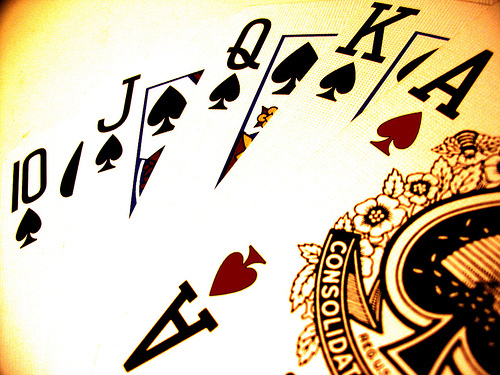Thinning the Field – Caro on Poker
Study all the scenarios before making your move
One of the weirdest impromptu poker lectures I ever witnessed happened in the player’s lounge near a poker room about 1986. Ralph was about 30, married, a father and the poster child for “Parents for Penny Pinching.” I mean, this guy actually grimaced if he had to buy his own cup of coffee. At poker, you could see him agonize before making every call.
Ralph was an accountant and looked the part. But unlike other number-oriented people I hung out with, he had no social talents whatsoever. It was a mystery to us how he managed to marry his beautiful wife. I’ve never met a man more analytical in my life, and his poker fortunes lately had been amazing. He couldn’t lose. His skill was based solely on dull, boring, hand analysis. His table image was that of a tree stump. He never chatted, never smiled, couldn’t read the most obvious tells, and didn’t think psychology was a worthy poker topic. It was all bland and all business when Ralph played poker.
And now he sits down unexpectedly beside me on a sofa and begins to speak. “The reason I like poker,” he says, “is because you can control your own destiny.”
“What’s that supposed to mean?” I counter. “The cards control your destiny in the short run. There’s nothing you can do about that.”
He uses this question to launch his lecture: “What do you do when you’re first to act in a limit hold ’em game and you have a pair of aces?”
I explain: “I don’t always do the same thing. Usually I’ll raise, but if there are some particularly aggressive players at the end of the line, I’ll just call the big blind, hoping that others will build the pot for me. Also, if it’s a table full of players who call with weak hands, I might just call, instead of raise, so as not to chase away their loose money.”
“That’s incorrect,” Ralph says, leaving me somewhat startled, because I’m sure I’ve done far more research on hold ’em than he has. And even though he’s analytical, I doubt that he has tools equal to the ones I’d developed to appropriately investigate how aces fare against various types of opponents. Nevertheless, I keep quiet as he attempts to make his case.
“Remember the key to poker is controlling your destiny,” Ralph asserts again. “The more opponents you play against, the more likely you are to get any hand beat, even aces. If you want to control your own destiny, you need to drive as many players out of the pot as possible when you have an advantage. That’s my secret.” Then he tediously details three illustrative hands he’s played.
When he finally finishes, looking smug and humorless and obviously certain he’s made his point, I stand up, stretch and say I must return to my game. “Sometimes I like to just call with aces,” I counter, leaving Ralph wondering if I’ve completely missed the force of his argument.
Ralph was wrong. In fact, there’s nothing wrong with just calling with aces before the flop in hold ’em. It’s true that you increase your risk of losing by inviting more opponents into the pot. But poker isn’t about winning pots; it’s about making the most long-term profit.
On average, when holding aces before the flop, you’ll make more profit in hold ’em against four or five opponents. Trying to cut your risk by playing against just one or two opponents is called “thinning the field.” It’s probably the most misunderstood and misused tactic in poker. Listen closely: Usually you shouldn’t try to thin the field.
Often players raise with strong hands hoping to thin the field and they fail. Then what? Then they succeeded in building a bigger pot. And that’s good. Their raise was right. But they did it for the wrong reason. The bad thing about “thin the field” strategy is that it tends to chase out the players with the weakest hands. That’s exactly what you don’t what to do if you’re hoping to maximize profit with a strong hand.
So, the sad part about thinning the field is that you often chase away the wrong opponents— the ones with the bad cards. And you end up stranded with the players with the good cards.
Oddly, though, there exists a good time for thinning the field. It’s when weak players have already committed to the pot and strong players remain to act after you. Then, when you raise, you’re likely to chase strong players out and play against a reduced field of weak opponents. That’s the perfect fit for thin-the-field strategy. However, if strong players are already in the pot and weak ones remain to act after you, it makes more sense to just call as an invitation to those weak players. Raising to thin the field would merely case away the profit. Think about these concepts next time you’re tempted to thin the field.
Oh, and about Ralph. He went broke and quit poker.
Mike Caro, “the Mad Genius of Poker” is today’s foremost authority on poker strategy, psychology, and statistics. He is the founder of Mike Caro University of Poker, with its online campus at Poker1.com. You often can play against him personally at DoylesRoom.com.



